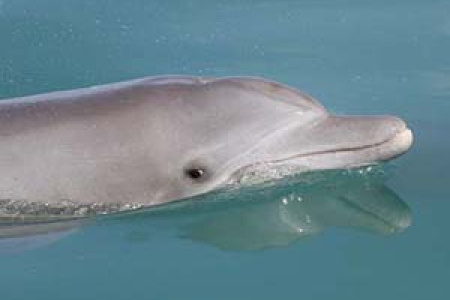Research aids NT marine conservation
With almost no information about whale or dolphin species in Northern Territory waters and development around the coast on the increase, PhD candidate Carol Palmer has discovered crucial information that will help conserve species for the future.
“There is nothing quite like locking eye contact with a six metre false killer whale as it surfaces along the side of the boat,” Dr Palmer said.
“There has been a real knowledge gap about the species of costal dolphins found in Top End waters.”
Since 2007, she has been scouring the coast and rivers, racking up more than 324 days on the water and traversing about 10,000 km of coastal areas in search of four species of dolphin known to inhabit the area.
“In 2007 almost no research had been carried out on either whales or dolphins in the Northern Territory,” she said. “We knew that to conserve and manage these species effectively we needed to improve our understanding of their distributions and abundance, and species genetics.”
She worked to gather genetic samples and also photograph the dorsal fins of the dolphins to identify individuals and provide baseline population estimates. She also worked to collate existing and historical data.
“The dorsal fins of dolphins are like a fingerprint,” she said. “Each one has markings or scars that we can use to distinguish individuals. We also started a community sighting database, where people could send in their pictures and videos of dolphins along with the GPS coordinates of where they were sighted.”
For the first time she began piecing together information about their population size and distribution in the NT, including the areas that were important for mothers and calves, and where they lived. These population estimates would be the first in monsoonal Northern Australia.
“What we now know is that the dolphins found in the NT occur is small groups of between one to 12 individuals, they are slow-growing and long-lived, living to the age of around 50 years,” she said. “They also only breed once they reach the age of six, have a long gestation period of 12 months and will parent their young for three or four years.”
Dr Palmer said that understanding these characteristics was important for the future management of the species.
“We have estimated there are approximately 200 snubfin dolphins in Coburg Marine Park spread widely in pods. That means that with a loss of as few as four breeding individuals in one year within this group, this population could start to decline,” she said.
“We also know that although some groups travel to the big tidal rivers to feed, they probably have a limited home range. We also think that the females don’t stray too far from where they are born. These characteristics combined mean that these species are naturally vulnerable.”
Dr Palmer’s genetic and taxonomic work has also helped to clarify the species status of the humpback and snubfin dolphins across Australia.
She will graduate at the CDU ceremony on Friday, 16 October. Her PhD thesis was entitled “Conservation Biology of Dolphins in Coastal Waters of the Northern Territory, Australia”.
